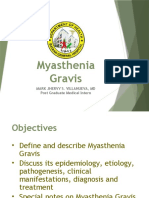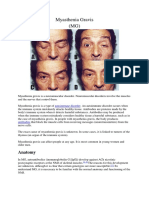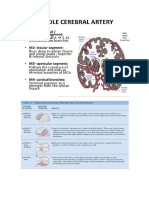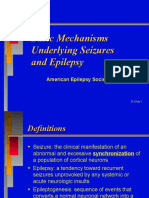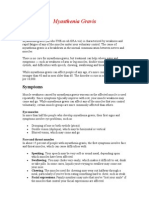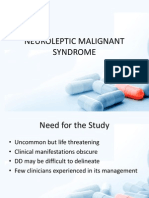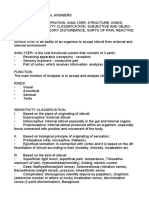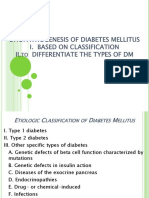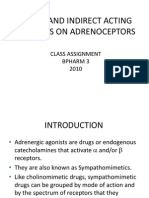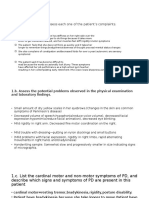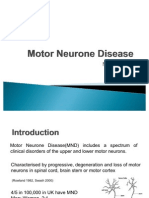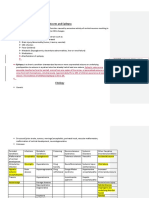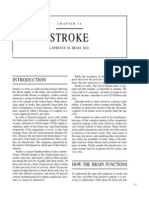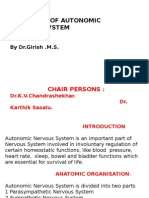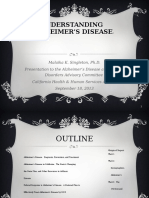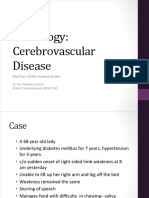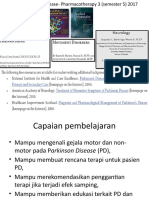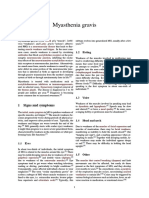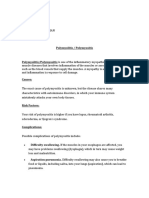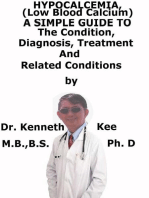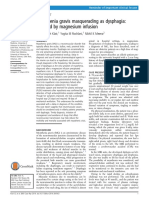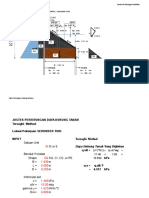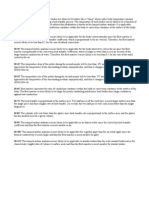100%(2)100% found this document useful (2 votes)
124 viewsMyasthenia Gravis
Myasthenia Gravis
Uploaded by
Bintari AnindhitaMyasthenia gravis (MG) is a neuromuscular disorder characterized by weakness and fatigability of skeletal muscles. It is caused by an autoimmune response mediated by specific anti-acetylcholine receptor antibodies. This results in a reduction of available acetylcholine receptors at the neuromuscular junction, impairing muscle activation. Symptoms include weakness that increases with repeated use of muscles and improves with rest. Ocular muscles are often initially affected, followed by oropharyngeal and limb muscles. Treatment focuses on acetylcholinesterase inhibitors, immunosuppression, and thymectomy in some cases.
Copyright:
© All Rights Reserved
Available Formats
Download as PPTX, PDF, TXT or read online from Scribd
Myasthenia Gravis
Myasthenia Gravis
Uploaded by
Bintari Anindhita100%(2)100% found this document useful (2 votes)
124 views17 pagesMyasthenia gravis (MG) is a neuromuscular disorder characterized by weakness and fatigability of skeletal muscles. It is caused by an autoimmune response mediated by specific anti-acetylcholine receptor antibodies. This results in a reduction of available acetylcholine receptors at the neuromuscular junction, impairing muscle activation. Symptoms include weakness that increases with repeated use of muscles and improves with rest. Ocular muscles are often initially affected, followed by oropharyngeal and limb muscles. Treatment focuses on acetylcholinesterase inhibitors, immunosuppression, and thymectomy in some cases.
Original Description:
myasthenia gravis, patophysiology
Original Title
Myasthenia Gravis.pptx
Copyright
© © All Rights Reserved
Available Formats
PPTX, PDF, TXT or read online from Scribd
Share this document
Did you find this document useful?
Is this content inappropriate?
Myasthenia gravis (MG) is a neuromuscular disorder characterized by weakness and fatigability of skeletal muscles. It is caused by an autoimmune response mediated by specific anti-acetylcholine receptor antibodies. This results in a reduction of available acetylcholine receptors at the neuromuscular junction, impairing muscle activation. Symptoms include weakness that increases with repeated use of muscles and improves with rest. Ocular muscles are often initially affected, followed by oropharyngeal and limb muscles. Treatment focuses on acetylcholinesterase inhibitors, immunosuppression, and thymectomy in some cases.
Copyright:
© All Rights Reserved
Available Formats
Download as PPTX, PDF, TXT or read online from Scribd
Download as pptx, pdf, or txt
100%(2)100% found this document useful (2 votes)
124 views17 pagesMyasthenia Gravis
Myasthenia Gravis
Uploaded by
Bintari AnindhitaMyasthenia gravis (MG) is a neuromuscular disorder characterized by weakness and fatigability of skeletal muscles. It is caused by an autoimmune response mediated by specific anti-acetylcholine receptor antibodies. This results in a reduction of available acetylcholine receptors at the neuromuscular junction, impairing muscle activation. Symptoms include weakness that increases with repeated use of muscles and improves with rest. Ocular muscles are often initially affected, followed by oropharyngeal and limb muscles. Treatment focuses on acetylcholinesterase inhibitors, immunosuppression, and thymectomy in some cases.
Copyright:
© All Rights Reserved
Available Formats
Download as PPTX, PDF, TXT or read online from Scribd
Download as pptx, pdf, or txt
You are on page 1of 17
KEPANITERAAN ILMU PENYAKIT SARAF RS PGI CIKINI
PERIODE 24 Juni 2013 20 Juli 2013
FAKULTAS KEDOKTERAN UNIVERSITAS KRISTEN INDONESIA
JAKARTA
Dosen Pembimbing :
dr. Hophoptua N. Manurung, Sp.S
Disusun oleh :
Bintari Anindhita (09-58)
Myasthenia gravis (MG) is a neuromuscular disorder
characterized by weakness and fatigability of
skeletal muscles.
The underlying defect..
antibody-mediated
autoimmune attack
acetylcholine receptors
(AChRs) at neuromuscular
junctions
The neuromuscular abnormalities in MG are
caused by an autoimmune response
mediated by specific anti-AChR antibodies.
There are 3 distinct mechanisms:
Rapid endocytosis of the receptors
Blockade of the active site of the achr
Damage to the postsynaptic muscle membrane
The thymus appears to play a role in autoimune
response in MG
The thymus is abnormal in ~75% of patients with MG
In ~65% the thymus is hyperplastic, with the presence of
active germinal centers detected histologically
An additional 10% of patients have thymic tumors
(thymomas).
Muscle-like cells within the thymus (myoid cells),
which bear AChRs on their surface, may serve as a
source of autoantigen and trigger the autoimmune
reaction within the thymus gland.
Number of
available ACHRs
The
postsynaptic
folds are
atrophic
Efficiency of
neuromuscular
transmission
Fail to trigger muscle
action
Potentials
Weakness of muscle
contraction
Normally..
The amount of ACh released per impulse declines
on repeated activity (termed presynaptic
rundown).
In the myasthenic patient..
Efficiency of
neuromuscular
transmission
Normal
rundown
Activation of fewer and
fewer muscle fibers by
successive nerve
impulses
Increasing
weakness, or
myasthenic
fatigue
The cardinal features weakness and
fatigability of muscles.
The weakness increases during repeated use
(fatigue) and may improve following rest or
sleep.
Exacerbations and remissions may occur,
particularly during the first few years after
the onset of the disease.
Ocular muscles affected first in about 40% of patients
and are ultimately involved in about 85% (Ocular MG)
Ptosis
Diplopia
Weakness of facial or oropharyngeal muscles, resulting in:
dysarthria,
dysphagia, and
limitation of facial movements.
Together, oropharyngeal and ocular weakness cause
symptoms in virtually all patients with acquired MG.
In ~85% of patients, the weakness becomes generalized,
affecting the limb muscles as well
often proximal and
may be asymmetric
Generalized
MG
A. Ptosis
B. Attempted gaze to
the right.
Only right eye
abducts incompletely.
C. Demonstrates
proximal
weakness upon
attempt to
raise the arms.
D. Holding the arms
and fingers extended
the extensor muscles
weaken and finger
drop occurs
Crisis occur in patients with oropharyngeal
or respiratory muscle weakness.
Provoked by..
respiratory infection
surgical procedures
emotional stress
systemic illness
Anticholinestrase test
Acetylcholinesterase Inhibitors
First line of therapy
Neostigmine bromide (Pyridostigmine)
Edrophonium chloride (Tensilon)
Immunosuppressive Therapy
Prednisone
Azathioprine
Plasmapheresis
Immunoglobulin Therapy
Thymectomy
Drachman, D. B. (2010). Myasthenia Gravis and Other Diseases of
the Neuromuscular Junction. In S. L. Hauser, & S. A. Josephson,
Harrison's Neurology in Clinical Medicine (2 ed., pp. 559-566). The
Mcgraw-Hill Companies.
Goldenberg, W. D., & Shah, A. K. (2013, February 11). Myasthenia
Gravis. (N. Lorenzo, Editor) Retrieved July 10, 2013, from
Medscape Drugs, Diseases & Procedures:
http://emedicine.medscape.com/article/1171206-overview
Penn, A. S., & Rowland, L. P. (2005). Myasthenia Gravis. In L. P.
Rowland, Merritt's Neurology (11 ed.). Lippincott Williams &
Wilkins.
You might also like
- Myasthenia Gravis Lecture 12Document59 pagesMyasthenia Gravis Lecture 12Pop D. MadalinaNo ratings yet
- Myasthenia GravisDocument31 pagesMyasthenia Gravisjsampsonemtp100% (2)
- Myasthenia Gravis: Mark Jhervy S. Villanueva, MD Post Graduate Medical InternDocument55 pagesMyasthenia Gravis: Mark Jhervy S. Villanueva, MD Post Graduate Medical InternJhervy VillanuevaNo ratings yet
- Drug Therapy For Parkinson's DiseaseDocument9 pagesDrug Therapy For Parkinson's DiseaseDireccion Medica EJENo ratings yet
- Demyelinating Diseases Pathology SY 2008-09Document25 pagesDemyelinating Diseases Pathology SY 2008-09skin_docNo ratings yet
- Multiple Sclerosis: Case Study by Trcoski ElenaDocument43 pagesMultiple Sclerosis: Case Study by Trcoski ElenaElena TrcoskiNo ratings yet
- Hassan Tonic - Clonic SeizureDocument12 pagesHassan Tonic - Clonic SeizureHassan.shehri100% (1)
- Myasthenia Gravis (MG) : AnatomyDocument12 pagesMyasthenia Gravis (MG) : AnatomyCici Novelia ManurungNo ratings yet
- Middle Cerebral ArteryDocument4 pagesMiddle Cerebral Arterykat9210No ratings yet
- Basic Mechanism of Epilepsy N SeizuresDocument44 pagesBasic Mechanism of Epilepsy N SeizurestaniaNo ratings yet
- Transverse MyelitisDocument16 pagesTransverse Myelitisahmicphd100% (1)
- Neuroleptic Malignant Syndrome MedscapeDocument9 pagesNeuroleptic Malignant Syndrome MedscapeEra SulistiyaNo ratings yet
- Disorder of The Neuromuscular Junction: Courtesy . DR - Syeda Afsheen Hasnain DPT/MSPT NeuroloicalDocument16 pagesDisorder of The Neuromuscular Junction: Courtesy . DR - Syeda Afsheen Hasnain DPT/MSPT NeuroloicalCHANGEZ KHAN SARDAR100% (1)
- Myasthenia GravisDocument6 pagesMyasthenia GravisNader Smadi100% (2)
- Neuroleptic Malignant SyndromeDocument18 pagesNeuroleptic Malignant Syndromedrkadiyala2No ratings yet
- Neurology pdf-1Document142 pagesNeurology pdf-1Ahmed Adel SaadNo ratings yet
- (Lippincott Williams & Wilkins Handbook Series) Randolph W. Evans MD, Ninan T. Mathew MD FRCP (C) - Handbook of Headache-Lippincott Williams & Wilkins (2005)Document428 pages(Lippincott Williams & Wilkins Handbook Series) Randolph W. Evans MD, Ninan T. Mathew MD FRCP (C) - Handbook of Headache-Lippincott Williams & Wilkins (2005)Mayra Alejandra Prada SerranoNo ratings yet
- Pathophysiology of Ischemic Stroke - UpToDateDocument11 pagesPathophysiology of Ischemic Stroke - UpToDateKarla AldamaNo ratings yet
- Transient Ischemic AttackDocument19 pagesTransient Ischemic Attackjoshua sondakhNo ratings yet
- Nervous System DiseasesDocument16 pagesNervous System DiseasesShahzad ShameemNo ratings yet
- Etiopathogenesis of Diabetes MellitusDocument35 pagesEtiopathogenesis of Diabetes MellitusironNo ratings yet
- Adrenergic AgonistsDocument40 pagesAdrenergic AgonistsBenedict Brashi100% (1)
- 1) A) List and Assess Each One of The Patient's ComplaintsDocument19 pages1) A) List and Assess Each One of The Patient's ComplaintsMuhammad HilmiNo ratings yet
- Motor Neuron DiseaseDocument23 pagesMotor Neuron DiseasenicolasuttonNo ratings yet
- Seizure and EpilepsyDocument18 pagesSeizure and EpilepsyJamal JosephNo ratings yet
- Movement Disorders BabcockDocument19 pagesMovement Disorders BabcockBaiq Trisna SatrianaNo ratings yet
- StrokeDocument19 pagesStrokesridhar100% (4)
- Disorders of Autonomic Nervous System: Chair PersonsDocument37 pagesDisorders of Autonomic Nervous System: Chair PersonswarunkumarNo ratings yet
- Understanding Alzheimer DiseaseDocument35 pagesUnderstanding Alzheimer DiseasenadyaNo ratings yet
- Neurogenic Shock: 23 September 2016Document10 pagesNeurogenic Shock: 23 September 2016royNo ratings yet
- ANIS Presentation-MULTIPLE SCLEROSIS IMAGINGDocument13 pagesANIS Presentation-MULTIPLE SCLEROSIS IMAGINGAnis EttehadulhaghNo ratings yet
- General Adaptation Syndrome TheoriesDocument4 pagesGeneral Adaptation Syndrome TheoriesHema JothyNo ratings yet
- Christina Amalia Pembimbing: Dr. Anik Widijanti, SP - PK (K)Document36 pagesChristina Amalia Pembimbing: Dr. Anik Widijanti, SP - PK (K)ChristinaNo ratings yet
- Demyelinating DisordersDocument29 pagesDemyelinating Disordersbpt2100% (2)
- Neurology (Cerebrovascular Disease)Document69 pagesNeurology (Cerebrovascular Disease)Mahadhir AkmalNo ratings yet
- Final Stroke MBDocument79 pagesFinal Stroke MBVanessa Yvonne GurtizaNo ratings yet
- AntiepilepticsDocument25 pagesAntiepilepticsMurali Krishna Kumar MuthyalaNo ratings yet
- Case Presentation About Spinal Shock SyndromeDocument56 pagesCase Presentation About Spinal Shock SyndromeAstral_edge010100% (1)
- Myasthenia GravisDocument3 pagesMyasthenia GravisfsNo ratings yet
- ParkinsonDiseaseFarter2017Document103 pagesParkinsonDiseaseFarter2017DISKA YUNIAROHIMNo ratings yet
- Autonomic and Systemic Pharmacology DR DahalDocument119 pagesAutonomic and Systemic Pharmacology DR Dahalअविनाश भाल्टरNo ratings yet
- Demyelinating DiseasesDocument76 pagesDemyelinating Diseasesapi-3743483100% (1)
- Duchenne Muscular Dystrophy (DMD)Document9 pagesDuchenne Muscular Dystrophy (DMD)rutwickNo ratings yet
- ParkinsonDocument2 pagesParkinsongoyaNo ratings yet
- Cerebrovasculara Ccident: Holy Angel University Angeles City College of NursingDocument124 pagesCerebrovasculara Ccident: Holy Angel University Angeles City College of Nursingninafatima allamNo ratings yet
- Muscular DystrophyDocument33 pagesMuscular DystrophyNurdina AfiniNo ratings yet
- Alzheimer's DiseaseDocument3 pagesAlzheimer's Diseasedarzy123No ratings yet
- Autonomic Nervous System - PPT 1Document98 pagesAutonomic Nervous System - PPT 1PROF DR SHAHMURAD100% (9)
- Myasthenia Gravis: 1 Signs and SymptomsDocument9 pagesMyasthenia Gravis: 1 Signs and SymptomsBugMyNutsNo ratings yet
- Frontal LobesDocument21 pagesFrontal LobesRikizu Hobbies100% (1)
- POLYMYOLITISDocument4 pagesPOLYMYOLITISAlexa Lexington Rae ZagadoNo ratings yet
- Diabetic Ketoacidosis PathwayDocument22 pagesDiabetic Ketoacidosis PathwaySri Nath100% (1)
- Hypocalcemia, (Low Blood Calcium) A Simple Guide To The Condition, Diagnosis, Treatment And Related ConditionsFrom EverandHypocalcemia, (Low Blood Calcium) A Simple Guide To The Condition, Diagnosis, Treatment And Related ConditionsNo ratings yet
- Myasthenia GravisDocument17 pagesMyasthenia GravisYanski DarmantoNo ratings yet
- Case Study Myasthenia GravisDocument9 pagesCase Study Myasthenia GravisYow Mabalot100% (1)
- Presented By: VIVEK DEVDocument38 pagesPresented By: VIVEK DEVFranchesca LugoNo ratings yet
- Klair 2014Document3 pagesKlair 2014PabloIgLopezNo ratings yet
- Diagnosis and Management of Myasthenia Gravis: ReviewDocument9 pagesDiagnosis and Management of Myasthenia Gravis: ReviewnetifarhatiiNo ratings yet
- Myasthenia Gravis (2016-2017) Lecture NotesDocument9 pagesMyasthenia Gravis (2016-2017) Lecture NotesJibril AbdulMumin KamfalaNo ratings yet
- Neuromuscular Junction DisordersDocument32 pagesNeuromuscular Junction Disordersepic sound everNo ratings yet
- Maghaway NHS Organizational Plan in School Based Solid Waste Management ProgramDocument1 pageMaghaway NHS Organizational Plan in School Based Solid Waste Management Programyollykim sisonNo ratings yet
- Uworld NotesDocument18 pagesUworld NotesNamRita PrasadNo ratings yet
- Physics PaperDocument16 pagesPhysics Paperonitha812sellerNo ratings yet
- Bahasa Inggris SmaDocument18 pagesBahasa Inggris SmaGloria TampubolonNo ratings yet
- M E Control SysDocument12 pagesM E Control Sys신영호No ratings yet
- TechTalk Kruppe Espasa RISC V Vectors and LLVMDocument23 pagesTechTalk Kruppe Espasa RISC V Vectors and LLVMLộc Nguyễn TấnNo ratings yet
- Engineering Properties of RocksDocument10 pagesEngineering Properties of RocksSachin Singh JatNo ratings yet
- Psi HD 8L Parts Book 12apr16 PDFDocument75 pagesPsi HD 8L Parts Book 12apr16 PDFJairo andres Guarnizo SuarezNo ratings yet
- Hematology PPT 1Document287 pagesHematology PPT 1Daniel lipphausNo ratings yet
- Stabilitas LerengDocument6 pagesStabilitas LerengMohamad HartadiNo ratings yet
- Lonely Planet - California's Best TripsDocument387 pagesLonely Planet - California's Best TripsjuanmjuizNo ratings yet
- Data SheetDocument168 pagesData SheetJorge Antonio Rodríguez VargasNo ratings yet
- Bio II Final Exam Review Without Standards (Answers)Document12 pagesBio II Final Exam Review Without Standards (Answers)Contessa PetriniNo ratings yet
- Solutions Assignment 7Document7 pagesSolutions Assignment 7Sammei DanniyelNo ratings yet
- LPG Horton Sphere Send EnquiryDocument3 pagesLPG Horton Sphere Send EnquiryAnonymous i743lcNo ratings yet
- Stone and SketchDocument4 pagesStone and SketchRickyNo ratings yet
- Ds0962117-0208902 Monitor 7in Rled RC 4 Cs en A02Document2 pagesDs0962117-0208902 Monitor 7in Rled RC 4 Cs en A02Nhàn Nguyễn ThanhNo ratings yet
- Mid 1 CT Final Examination For First Year StudentsDocument4 pagesMid 1 CT Final Examination For First Year Studentshabtamu100% (1)
- KVS PGT Question PaperDocument117 pagesKVS PGT Question Papergauravhchavda100% (2)
- Ciat Ventilatoare Tip TurelaDocument7 pagesCiat Ventilatoare Tip TurelapintileirobertNo ratings yet
- DILG Memo Circular 2012223 0e1b0f1390Document22 pagesDILG Memo Circular 2012223 0e1b0f1390Roselle Asis- Napoles100% (1)
- BEEA MT1 Exam-QuestionsDocument38 pagesBEEA MT1 Exam-QuestionsSofhia Claire YbañezNo ratings yet
- Alvarion Walkair - Carritech TelecommunicationsDocument2 pagesAlvarion Walkair - Carritech TelecommunicationsCarritech TelecommunicationsNo ratings yet
- ShopNotes #93 (Vol 16) - Router Accesories & Add Ons PDFDocument53 pagesShopNotes #93 (Vol 16) - Router Accesories & Add Ons PDFSteveNo ratings yet
- Pseudomembranous ColitisDocument18 pagesPseudomembranous ColitisaaaaaNo ratings yet
- Crochet Reindeer EarsDocument2 pagesCrochet Reindeer EarsEllen K100% (2)
- Grade 8Document10 pagesGrade 8Darshi KarunarathneNo ratings yet
- In The End - Linkin ParkDocument4 pagesIn The End - Linkin ParkIngridCordeiro94No ratings yet
- Answer All Questions.: Sulit 3472/1Document16 pagesAnswer All Questions.: Sulit 3472/1azirawaniNo ratings yet
- Briess 2006CBC Balancing WaterDocument33 pagesBriess 2006CBC Balancing WaterSergio LopezNo ratings yet


